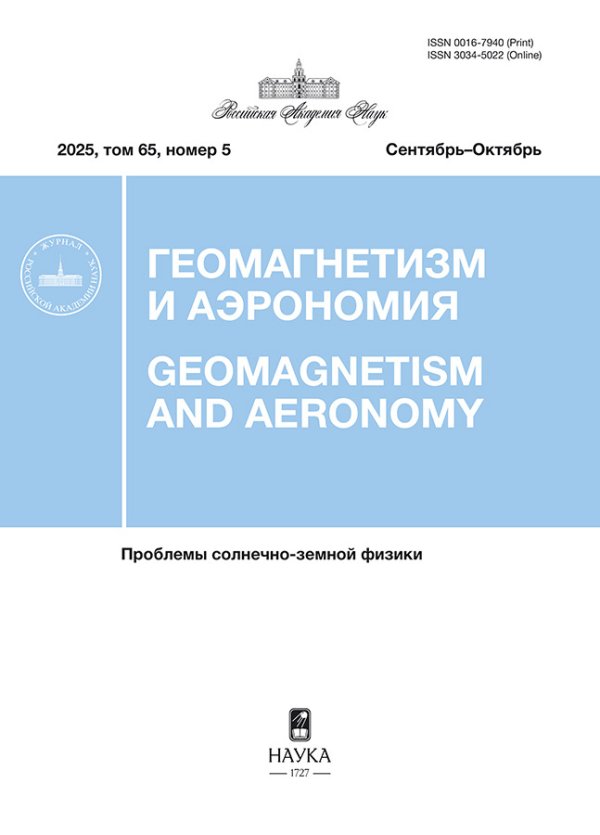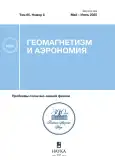ОЦЕНКА ПРОГНОЗА МОДУЛЯЦИИ ГАЛАКТИЧЕСКИХ КОСМИЧЕСКИХ ЛУЧЕЙ В 25-М ЦИКЛЕ СОЛНЕЧНОЙ АКТИВНОСТИ
- Авторы: Струминский А.Б.1, Белов А.В.2, Гущина Р.Т.2, Янке В.Г.2, Григорьева И.Ю.3
-
Учреждения:
- Институт космических исследований РАН (ИКИ РАН)
- Институт земного магнетизма, ионосферы и распространения радиоволн им. Н.В. Пушкова РАН (ИЗМИРАН)
- Главная (Пулковская) астрономическая обсерватория РАН (ГАО РАН)
- Выпуск: Том 65, № 3 (2025)
- Страницы: 324-334
- Раздел: Статьи
- URL: https://ogarev-online.ru/0016-7940/article/view/304381
- DOI: https://doi.org/10.31857/S0016794025030039
- EDN: https://elibrary.ru/esaagb
- ID: 304381
Цитировать
Аннотация
Об авторах
А. Б. Струминский
Институт космических исследований РАН (ИКИ РАН)
Email: astrum@cosmos.ru
Москва, Россия
А. В. Белов
Институт земного магнетизма, ионосферы и распространения радиоволн им. Н.В. Пушкова РАН (ИЗМИРАН)
Email: yanke@izmiran.ru
Москва, Троицк, Россия
Р. Т. Гущина
Институт земного магнетизма, ионосферы и распространения радиоволн им. Н.В. Пушкова РАН (ИЗМИРАН)Москва, Троицк, Россия
В. Г. Янке
Институт земного магнетизма, ионосферы и распространения радиоволн им. Н.В. Пушкова РАН (ИЗМИРАН)
Email: yanke@izmiran.ru
Москва, Троицк, Россия
И. Ю. Григорьева
Главная (Пулковская) астрономическая обсерватория РАН (ГАО РАН)Санкт-Петербург, Россия
Список литературы
- Гущина Р.Т., Белов А.В., Обридко В.Н., Шельтинг Б.Д. Проявления циклических вариаций магнитного поля Солнца в долговременной модуляции космических лучей // Геомагнетизм и аэрономия. Т. 48. № 5. С. 598–604. 2008
- Крайнев М.Б., Базилевская Г.A., Калинин М.С., Михайлов В.В., Свиржевская А.К. Свиржевский Н.С. Пятьдесят лет исследования поведения интенсивности ГКЛ в периоды инверсии гелиосферного магнитного поля. I. Наблюдаемые эффекты //Солнечно-земная физика. Т. 9. № 4. С. 5−20. 2023
- Ныммик Р.А. Модель галактических космических лучей, Глава 1.6 в книге Модель космоса: научно-информационное издание в 2 т. / Под редакцией М.И. Панасюка, Л.С. Новикова. Т. 1: Физические условия в космическом пространстве. М.: КДУ, 2007. 872 с.: табл. ил.
- Обридко В.Н. Магнитные поля и индексы активности, параграф 1.4 Главы 1 в книге Плазменная гелиогеофизика. В 2 т. Т. I / Под ред. Л.М. Зеленого и И.С. Веселовского. М.: ФИЗМАТЛИТ, 2008. - 672 с.
- Aguilar M., Ali Cavasonza L., Ambrosi G., Arruda L., Attig N. et al., (AMS Collaboration). Temporal Structures in Electron Spectra and Charge Sign Effects in Galactic Cosmic Rays // Phys. Rev. Lett. V. 130. 161001. 2023. https://doi.org/10.1103/PhysRevLett.130.161001
- Babcock H.W. The topology of the Sun’s magnetic field and the 22-year cycle //Astropys. J. V. 133. P. 572–578. 1961. https://doi.org/10.1086/147060
- Belov A. Large scale modulation: view from the Earth // Space Sci. Rev. V. 93. P. 79–105. 2000. https://doi.org/10.1023/A:1026584109817
- Charbonneau P. Dynamo models of the solar cycle // Living Reviews in Solar Physics. V. 17. Iss. 4. 2020. https://doi.org/10.1007/s41116-020-00025-6
- Cliver E.W. The Extended Cycle of Solar Activity and the Sun’s 22-Year Magnetic Cycle // Space Sci. Rev. V. 186. P. 169–189. 2014. https://doi.org/10.1007/s11214-014-0093-z
- Cliver E.W., Richardson I.G., Ling A.G. Solar Drivers of 11-yr and Long-Term Cosmic Ray Modulation // Space Sci. Rev. V. 176. P. 3–19. 2013. https://doi.org/10.1007/s11214-011-9746-3
- Fisk L.A., Axford W.I. Solar Modulation of Galactic Cosmic Rays, 1 // J. Geophys. Res. V. 74. N 21. P. 4973–4986.1969. https://doi.org/10.1029/JA074i021p04973 .
- Gleeson L.J., Axford W.I. Cosmic Rays in the Interplanetary Medium // Astrophys. J. V. 149. P. L115–L118. 1967. https://doi.org/10.1086/180070
- Hale G.E., Ellerman F., Nicholson S.B., Joy A.H. The magnetic polarity of Sun-spot // Astrophys. J. V. 49. P.153. 1919. https://doi.org/10.1086/142452
- Hathaway D.H. The Solar Cycle // Living Rev. Solar Phys. V. 12. P. 4. 2015. https://doi.org/10.1007/lrsp-2015-4
- Jha B.K. and Upton L.A. Predicting the Timing of the Solar Cycle 25 Polar Field Reversal // Astrophys. J. V. 962. P. L15-L21. 2024. https://doi.org/10.3847/2041-8213/ad20d2
- Jiang J., Cameron R.H., and Schüssler M. The cause of the weak solar cycle 24 // Astrophys. J. Lett. V. 820. P. L28-L34. 2015. https://doi.org/10.1088/2041-8205/808/1/L28
- Jokipii J.R, Levy E.H., and Hubbard W.B. Effects of particle drift on cosmic-ray transport. I. General properties, application to solar modulation // Astrophys. J. V. 213. P. 861−868. 1977. https://doi.org/10.1086/155218
- Jokipii J.R., Thomas B. Effects of drift on the transport of cosmic rays IV. Modulation by a wavy interplanetary current sheet // Astrophys. J. V. 243. P. 1115−1122.1981. https://doi.org/10.1086/158675
- Khabarova O., Malandraki O., Malova H., Kislov R. et al. Current Sheets, Plasmoids and Flux Ropes in the Heliosphere Part I. 2-D or not 2-D? General and Observational Aspects // Space Sci. Rev. V. 217:38. 2021. https://doi.org/10.1007/s11214-021-00814-x
- Kumar P., Nagy M., Lemerle A., Karak B.B., Petrovay K. The polar precursor method for solar cycle prediction: comparison of predictors and their temporal range// Astrophys. J. V. 909. P 87−99. 2021. https://doi.org/10.3847/1538-4357/abdbb4
- Kumar P., Karak B.B., Sreedevi A. Variabilities in the polar field and solar cycle due to irregular properties of bipolar magnetic regions // MNRAS. V. 530. P. 2895–2905. 2024. https://doi.org/10.1093/mnras/stae1052
- Leighton R.B. Transport of magnetic fields on the Sun // Astrophys. J. V. 140. P. 1547–1562. 1964. https://doi.org/10.1086/148058
- Leighton R.B. A magneto-kinematic model of the solar cycle //Astrophys. J. V. 156. P. 1–26. 1969. https://doi.org/10.1086/149943
- Liu W., Guo J., Wang Yu., and Slaba T.C. A Comprehensive Comparison of Various Galactic Cosmic-Ray Models to the State-of the-art Particle and Radiation Measurements // Astrophys. J. V. 271. P. 18−47. 2024. https://doi.org/10.3847/1538-4365/ad18ad
- Martin S.F. Observations key to understanding solar cycles: a review // Front. Astron. Space Sci. V. 10:1177097. 2024. https://doi.org/10.3389/fspas.2023.1177097
- Nandy D. Progress in Solar Cycle Predictions: Sunspot Cycles 24–25 in Perspective // Solar Phys. V. 296:54. 2021. https://doi.org/10.1007/s11207-021-01797-2
- Owens M.J., Lockwood M., Barnard L. A. et al. Extreme Space-Weather Events and the Solar Cycle // Solar Phys. V. 296:82. 2021. https://doi.org/10.1007/s11207-021-01831-3
- Pal S. and Nandy D. Algebraic quantification of the contribution of active regions to the Sun’s dipole moment: applications to century-scale polar field estimates and solar cycle forecasting // MNRAS. V. 531. P. 1546–1553. 2024. https://doi.org/10.1093/mnras/stae1205
- Parker E.N. The Passage of Energetic Particles through Interplanetary Space //Planetary Space Sci. V. 13. P. 9–49. 1965. https://doi.org/10.1016/0032-0633(65)90131-5
- Paouris E., Mavromichalaki H., Belov A, Gushchina R., Yanke V. Galactic Cosmic Ray Modulation and the Last Solar Minimum // Solar Phys. 2012. V. 280. P. 255–271. https://doi.org/10.1007/s11207-012-0051-4
- Petrovay K. Solar cycle prediction // Living Rev. Sol. Phys. V. 17: 2. 2020. https://doi.org/10.1007/s41116-020-0022-z
- Svaalgaard L., Wilcox J. A View of Solar Magnetic Fields, the Solar Corona and the Solar Wind in Three Dimensions // Ann. Rev. Astron. Astrophys. V. 16. P. 429−443. 1978. https://doi.org/10.1146/annurev.aa.16.090178.002241
- Stozhkov Yu.I., Makhmutov V.S., Svirzhevsky N.S. About cosmic ray modulation in the heliosphere // Universe. Vol. 8. Iss. 11. P. 558. 2022. https://doi.org/10.3390/universe8110558
- Wang Y.-M. The Radial Interplanetary Field Strength at Sunspot Minimum as Polar Field Proxy and Solar Cycle Predictor //Astrophys. J. Lett. V. 96. P. L27-L36. 2024. https://doi.org/10.3847/2041-8213/ad1c65
- Yanke V.G., Belov A.V., Gushchina R.T., Kobelev P.G., Trefilova L.A. Forecast of Modulation of Cosmic Rays with Rigidity of 10 GV in the 25th Solar Activity Cycle // Geomagn. Aeronomy. V. 64. N 2. P. 201–210. 2024. https://doi.org/10.1134/S0016793223601072
Дополнительные файлы










